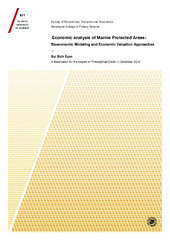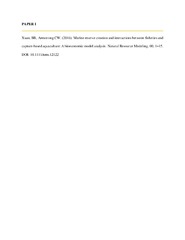| dc.contributor.advisor | Armstrong, Claire | |
| dc.contributor.author | Bui, Bich Xuan | |
| dc.date.accessioned | 2017-04-10T12:05:43Z | |
| dc.date.available | 2017-04-10T12:05:43Z | |
| dc.date.issued | 2017-04-05 | |
| dc.description.abstract | Marine protected areas (MPAs) are often established for conservation objectives. Benefits provided by MPAs exceed pure biodiversity conservation as they may include contributions to social and economic benefits of local communities. And though it is still debated, MPAs may provide a management tool for sustainable fisheries and/or solving conflicts of interests between users of marine resources. It is of value to analyze and understand how implementation of an MPA can give different benefits to the economy and society. This thesis attempts to analyze some of the benefits of MPAs in specific situations. The thesis includes two parts; part 1 presents the general introduction of the thesis and part 2 consists of three papers. There are three main sections in the introduction. The first section presents the basic literature on the use of natural resources and MPAs, as well a description of the Nha Trang Bay marine protected area (NTB MPA) as an empirical case study. The second section presents research objectives and the summary of three topics dealing with these objectives. The first topic describes how an MPA can be used as a management tool to solve economic conflicts between ocean users, more specifically aquaculture and wild commercial fisheries competing for the use of the same species. An integrated bioeconomic model is developed for analyzing the impacts of an MPA on aquaculture-fisheries interactions. In the second topic, benefits from MPA-based tourism activities are derived using the discrete choice experiment method. The empirical analysis is applied to the NTB MPA in Vietnam. The total benefits of the coexistence of multiple activities, i.e. fisheries and tourism, affected by MPAs is analyzed and discussed in the third topic. The combination of a bioeconomic model and non-market valuation techniques (i.e. discrete choice experiment) is the approach for this study. Data from the anchovy purse seine fishery in Khanh Hoa province and tourism activities related to the NTB MPA are applied for the empirical analysis. The final section presents overall conclusions of the thesis. | en_US |
| dc.description.doctoraltype | ph.d. | en_US |
| dc.description.popularabstract | Marine protected areas (MPAs) are often established for conservation objectives. Benefits provided by MPAs exceed pure biodiversity conservation as they may include contributions to social and economic benefits of local communities. And though it is still debated, MPAs may provide a management tool for sustainable fisheries and/or solving conflicts of interests between users of marine resources. It is of value to analyze and understand how implementation of an MPA can give different benefits to the economy and society. This thesis attempts to analyze some of the benefits of MPAs in specific situations. The thesis includes two parts; part 1 presents the general introduction of the thesis and part 2 consists of three papers. There are three main sections in the introduction. The first section presents the basic literature on the use of natural resources and MPAs, as well a description of the Nha Trang Bay marine protected area (NTB MPA) as an empirical case study. The second section presents research objectives and the summary of three topics dealing with these objectives. The first topic describes how an MPA can be used as a management tool to solve economic conflicts between ocean users, more specifically aquaculture and wild commercial fisheries competing for the use of the same species. An integrated bioeconomic model is developed for analyzing the impacts of an MPA on aquaculture-fisheries interactions. In the second topic, benefits from MPA-based tourism activities are derived using the discrete choice experiment method. The empirical analysis is applied to the NTB MPA in Vietnam. The total benefits of the coexistence of multiple activities, i.e. fisheries and tourism, affected by MPAs is analyzed and discussed in the third topic. The combination of a bioeconomic model and non-market valuation techniques (i.e. discrete choice experiment) is the approach for this study. Data from the anchovy purse seine fishery in Khanh Hoa province and tourism activities related to the NTB MPA are applied for the empirical analysis. The final section presents overall conclusions of the thesis. | en_US |
| dc.description | The papers 2 and 3 of this thesis are not available in Munin. <br>
Paper 2: Xuan, B. B., Sandorf, E. D., Aanesen, M.: “Informing Management Strategies for a Reserve: Results from a Discrete Choice Experiment Survey”. (Manuscript). <br>
Paper 3: Xuan, B. B.: “Extractive and Non-extractive Values of a Marine Protected Area: A Bio-economic Model Application". (Manuscript). | en_US |
| dc.identifier.isbn | 978-82-8266-135-5 | |
| dc.identifier.uri | https://hdl.handle.net/10037/10946 | |
| dc.language.iso | eng | en_US |
| dc.publisher | UiT The Arctic University of Norway | en_US |
| dc.publisher | UiT Norges arktiske universitet | en_US |
| dc.rights.accessRights | openAccess | en_US |
| dc.rights.holder | Copyright 2017 The Author(s) | |
| dc.rights.uri | https://creativecommons.org/licenses/by-nc-sa/3.0 | en_US |
| dc.rights | Attribution-NonCommercial-ShareAlike 3.0 Unported (CC BY-NC-SA 3.0) | en_US |
| dc.subject | VDP::Agriculture and fishery disciplines: 900::Fisheries science: 920::Other fisheries disciplines: 929 | en_US |
| dc.subject | VDP::Landbruks- og Fiskerifag: 900::Fiskerifag: 920::Andre fiskerifag: 929 | en_US |
| dc.title | Economic analysis of Marine Protected Areas: Bioeconomic Modeling and Economic Valuation Approaches | en_US |
| dc.type | Doctoral thesis | en_US |
| dc.type | Doktorgradsavhandling | en_US |


 English
English norsk
norsk


